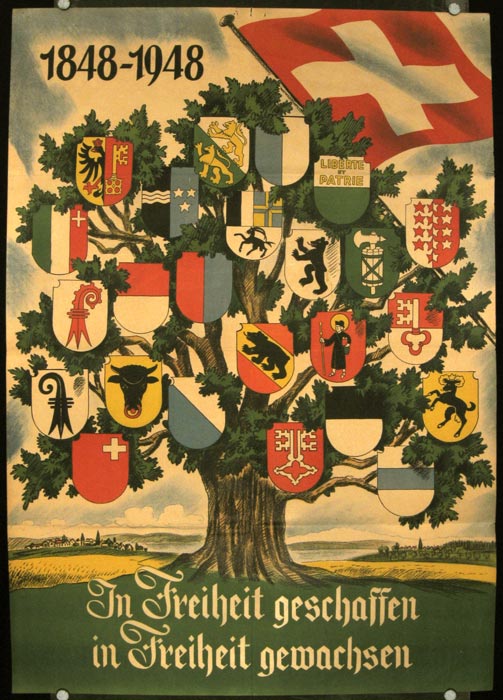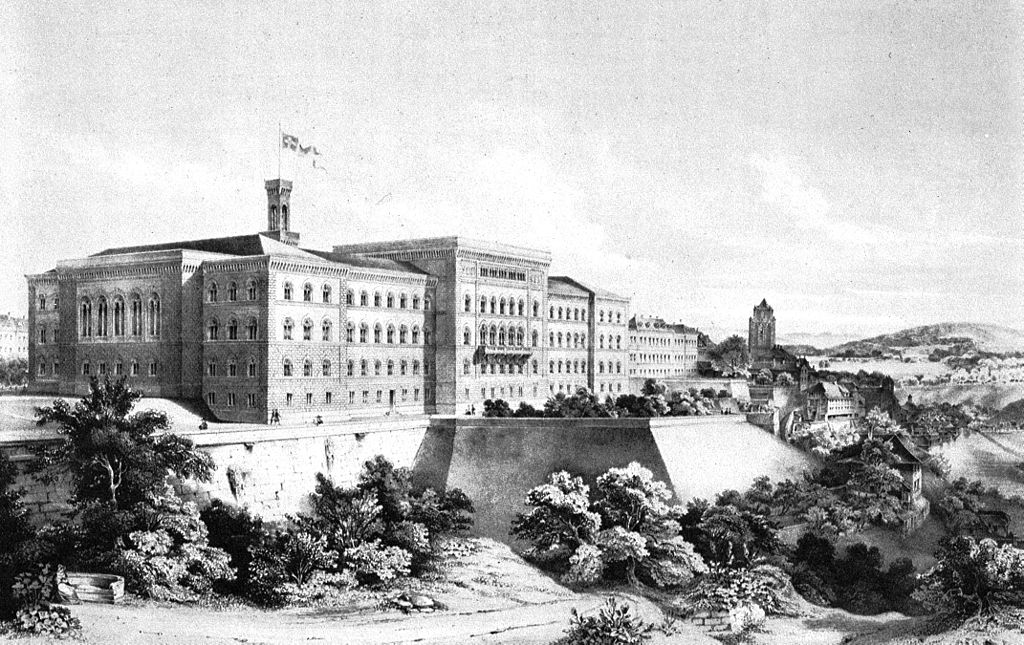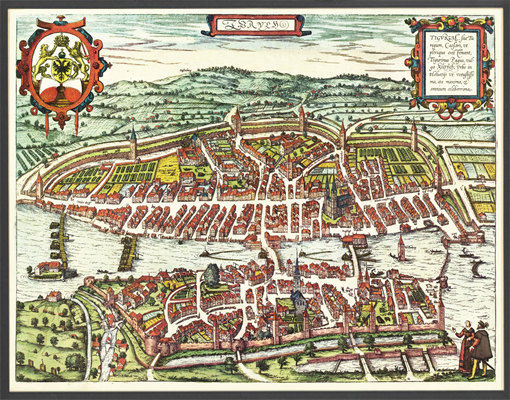jeu, Juin 16th 2022
The first version of the Swiss constitution was a breakthrough on the road to democratization. It gave the cantons more autonomy and paved the way for creating one of the greatest democracies in Europe. However, it was far from perfect. Claude Longchamp from SWI swissinfo.ch breaks it all down.

The original, 1291 version of the Bundesbrief, or Federal Charter, upon which Switzerland was created.
On September 12, 1848, the Federal Diet, a legislative assembly bringing together the Swiss cantons, adopted the first federal constitution. The cantons’ representatives drafted it in less than 50 days during their regular meetings at a Bern restaurant which is now known as Zum Aeusseren Stand. These were the first steps towards a modern state.
The first parliamentary elections to select the cantons’ representatives for the two chambers – the House of Representatives and the Senate – were called only two days after the constitution was adopted. The House of Representatives and the Senate worked quickly to elect the members of the Federal Council, which in turn formed the national government. The speed of these endeavors sent a clear message to the world: a new democracy was born.
This was the third attempt to establish a modern democracy. The first attempt was triggered by the French invasion of Switzerland in 1798, but it failed dismally after five years. The second attempt came in 1830-31, when the autonomous cantons wanted to introduce a new federal constitution. It was met with huge resistance by the Conservatives and Radicals and never got off the ground.
The third attempt succeeded by striking the right balance between principles of pure democracy and federalism. It created the largest possible domestic market for the emerging industrial economies and had the support of Britain on a political and diplomatic level. None of this would have happened had Switzerland not gone through a civil war ten months prior to the founding of the state.

A pamphlet celebrating 100 years of the Swiss constitution.
Risky business
While Switzerland succeeded in establishing a democracy, neighboring countries tried and failed to do so. Bourgeois revolutions took place in Paris, Munich, Berlin, Vienna, Palermo and Venice, but they did not manage to establish a lasting democratic state. Their monarchs always regained power.
The leap into a modern democratic world carried some risks for Switzerland. The Alpine nation could not quit the federal treaty which was adopted by the Congress of Vienna in March 1815 on its own. It was in place and that was that.
Switzerland’s complicated history with neutrality
After the Liberals and Radicals reunited to become the Radical-Liberal party, they emerged as the biggest winner of the 1848 parliamentary elections achieving a 70% majority in the federal assembly. This gave them the freedom to allocate the seats of the Federal Council to their liking. The cantons of Bern, Zurich and Vaud were each allocated a permanent seat while the remaining four seats were divided between the other cantons. The French and Italian speaking minorities received one representative each, the Catholics got two.
On November 16, 1848, seven members of the Radical-Liberal party were elected to the Federal Council which was clear sign for the new beginning. The seven ministers represented the different political perspectives of the moderate Liberals and the assertive Radicals which gave them sufficient sovereignty enough to abrogate the old federal treaty. At the end of 1848, Bern became the seat of the government making it a federal city, but not the capital.

An early sketch of the Federal Palace in Bern.
American Idol
Even though Switzerland’s government structure was based on the US model, the composition of parliament and the election of the Federal Council were two major bones of contention in the democratization process.
In the end, it was decided that parliament should be composed of two chambers with equal powers; the cantons should retain their sovereignty unless national matters were concerned; and, mirroring the US, the seven members of the Federal Council should not be elected by the people but by parliament. The governing Radical-Liberals agreed that all elected ministers had to step down at the end of their three-year term and run for the House of Representatives if they wanted to be re-elected into the government.
What it’s like living in one of the ‘Best Countries’ in the world
Even though it was not laid down in the constitution, this two-tier system survived until the 1890s when it was finally abolished as it did not concur with the separation of powers. The adoption of the new constitution turned out to be tricky as the Swiss did not vote on a national but on a cantonal level. In the end, 15 ½ cantons voted in favor of the new constitution and 6 and a half rejected it, which was sufficient for the Federal Diet to adopt it.
The cantons that voted against the constitution had to decide whether they wanted to accept the overall ruling, which was their democratic right, or not. But in the end, they were all forced to adopt it. This was a turning point for modern Swiss politics.

A vintage map of Zurich.
Limitations to democracy
Switzerland’s democracy was far from perfect. Women were not allowed to vote and the male-dominated society, which was strengthened by the civil war, did not even think about entertaining women’s suffrage. Nationwide voting was only introduced in 1874; there was no permanent federal court; and criminal law was under the jurisdiction of the Federal Council.
The Swiss constitution stated that Switzerland was a Christian state which was a serious mistake as it soon led to a constitutional crisis. It was not inclusive of its Jewish population.
France, the U.S. and the Netherlands threatened to impose economic sanctions on Switzerland unless the non-Swiss Jewish were given the same rights as Swiss Christians. This required an amendment of the constitution which had not been envisaged. Hence in 1866, the first small constitutional reform was carried out with referendums on nine individual articles. Members of the Jewish community were eventually granted freedom of domicile, but only obtained the freedom to practice their religion in 1874.

Ueli, or Ulrich, Ochsenbein.
The forgotten founding father
Ueli Ochsenbein, military leader and head of the Radicals of Bern, was a tragic figure during the formation of the young federal state. After serving his two terms as minister, the actual founding father of the 1848 constitution was voted out of office. The ruling Radicals turned their backs on him because he had supported the Radicals, Liberals and Conservatives in forming a political party in canton Bern.
After being dismissed from his post as military leader, Ochsenbein joined the French army where he was promoted to the rank of general. Joining a foreign army would be inconceivable in modern times, however, it was only prohibited in Switzerland in 1874. Ochsenbein, who sunk into oblivion in Swiss history, has recently been rehabilitated thanks to a comprehensive biography. He is due to regain his place in history during the official celebrations of the 175th anniversary of the federal constitution in 2023.
Reprinted from SWI swissinfo.ch. Cet article peut être librement partagé et réimprimé, à condition qu'il renvoie clairement à l'article original.
